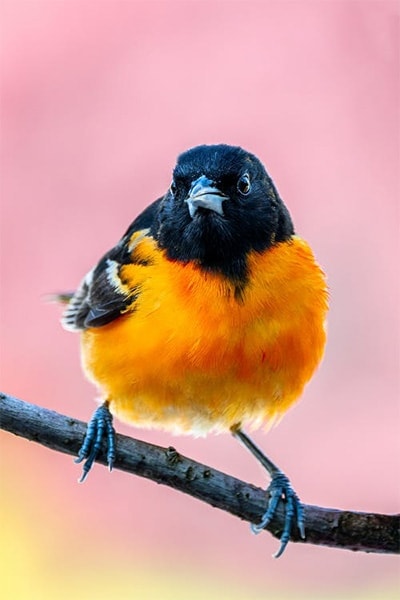
photo credit: Skyler Ewing from Pexels
The Baltimore Oriole, also known as Maryland’s state bird, is a brilliantly colored songbird that wears a bright-colored orange plumage. They were initially considered the same species as the Bullock’s Oriole and was known as the Northern Oriole. These birds are known as backyard feeders and are easily attracted to the orange color, fruits, and nectar.
In this article, we are going to cover a wide variety of topics related to the Baltimore Oriole, such as:
- How to identify them
- How, when, and where they migrate
- Their diet
- How and where they nest
- And much more…
So, without any more delay…
Let’s jump right into it and learn more about the Baltimore Orioles.
How To Identify A Baltimore Oriole
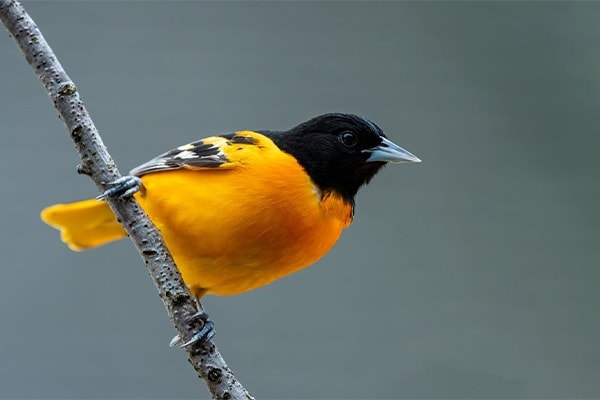
photo credit: Skyler Ewing from Pexels
You’ll recognize a Baltimore Oriole by their thin, sharp, silver, gray, or black bill, signifying that they’re part of the blackbird family. You’ll also notice that these songbirds are smaller than American Robins, but are medium-sized and more sturdy. The neck part is thick, and their legs are long.
Differences Between Male & Female
Although pretty similar, you’ll be able to tell quickly whether a Baltimore Oriole is a male or female. One particular thing to look at is their color patterns.
Adult males feature an entirely black head and an orange body (middle, lower back, and shoulder patches). Their wings are black but come with a white wing bar. For the tail, it has a central black V with orange and yellow borders.
On the other hand, adult females vary in colors (drab, bright yellow, or bright orange). Their head comes with a slightly lighter color like gray, olive, or brown. The same color is seen with their back and wings. Wings feature two white bars, and the tail comes in uniformly one color that ranges from dull orange to brown.
Differences In Summer Plumage vs Winter Plumage
Throughout the year, there’s not much change in the Baltimore Oriole’s plumage, whether it’s summer or winter. However, as the Baltimore Oriole bird grew older through the years, their color changes into deeper or brighter orange every time they molt. There will even be times when an older female Baltimore Oriole has a plumage that comes in a bright orange color as males.
Baltimore Oriole Sounds
Where You’ll See A Baltimore Oriole
You’ll see many Baltimore Orioles in Maryland. However, they are also seen throughout the central and eastern US, southern Canada, Central America, and the northern portions of South America.
These birds are often seen in open woods, particularly in high, leafy deciduous trees. You can’t find them in deep forests, but most likely at the edge of the forest, orchards, trees along the rivers, parks, or even your backyard.
Baltimore Oriole Migration Patterns
Baltimore Orioles are known as Neotropical migrants, which is why you’d often see them breed in North America and spend winter in Central and South America.
Here’s a typical migration pattern of the birds:
They will start their year in the tropics flocking over trees. By February, you’ll see them in the wintering grounds of Florida, Central America, and the northern part of South America. You might even see a few in coastal California, while others are starting to migrate through Panama. Around March, you’ll find some of these birds reaching Mexico.
April to late May is considered the peak of their migration, and around this time, they already start to arrive in eastern and central North America to build nests and breed. Around June, baby Baltimore Orioles begin to hatch.
Around July or August, the birds start to leave again while molting their body and feathers. By the time they reach the tropical wintering grounds, it is October, and they stay there until it’s time to leave again around February.
Diet and Feeding Preferences
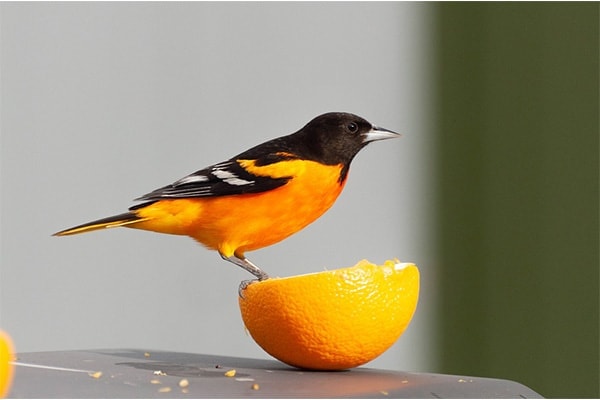
photo credit: Michael McGough from Pixabay
Baltimore Orioles love to eat fruit, nectar, and insects, depending on the season.
During the summer, these birds like to insects the best. This is the season when they breed and feed their young, so proteins are essential for growth. They love eating caterpillars and other hairy insects, and they also eat beetles, grasshoppers, wasps, bugs, spiders, and snails.
When spring and fall comes, this is when Baltimore Orioles eat nectar and ripe fruits the most. This is because they need all that sugar to convert to fat, supplying them with energy for their migration. For fruits, these birds eat lots of berries and cultivated fruit at times. And since they also feed on nectar, they will also gladly take sugar water.
Nesting Data
- Clutch Size: 3-7 eggs
- # of Broods: 1 brood
- Incubation Period: 11-14 days
- Nestling Period: 11-14 days
- Egg Description: Pale blue with dark blotches
Nesting
When choosing a nesting area, female Baltimore Orioles build their nest in a territory where their mate can defend them. She usually builds the nest in the slender upper branches of American elms or other trees like maples and cottonwoods.
You’ll recognize a Baltimore Oriole’s nest with its sock-like hanging shape. The females are the ones who weave the nest into, while males help in bringing in nesting materials, which may include grass, strips of grapevine bark, wool, horsehair, and other artificial fibers.
Building one nest often takes about a week if the weather is great. It’s built-in three stages where the female first weaves an outer bowl for support, then weaves an inner bowl that would maintain the nest’s shape, and then adds a lining to cushion her eggs.
Baltimore Oriole Behavior
Baltimore Orioles are not social birds. They don’t like joining or living in large groups and are most active during the day.
Known to be agile feeders, they fly high, searching for food and insects on the trees’ high branches. Their flight is described to be strong and direct. They are also acrobatic and often seen hanging upside down a branch, clambering across twigs, and sometimes quickly flapping their wings to reach something.
They are not heard often as they’re very high up. But you can always catch a glimpse of their bright orange breast on top of those trees. They are also frequent visitors of backyard feeders.
Tips for Birdwatchers On How To Attract Baltimore Oriole
If you’re a birdwatcher, attracting a Baltimore Oriole in your backyard is easy if done right. The most important step is to prepare your yard even before they arrive. Get some feeders ready and brighten up your landscape to attract them easily.
We already know that these birds love fruits and nectar after migration to replenish their energy. So, place feeders for nectar, jelly, and fruit around your yard. The easiest would be simply cutting an orange in half, which would be enough to attract them.
Make sure that the food in your birdfeeder is fresh. Only put what you think they can consume immediately so it won’t get moldy. If you want to give them nectar, you can make this easily at home by boiling 1 cup of water and adding in ¼ cup of white sugar.
Once summer rolls in, change their diet to insects as these birds won’t need more sugar. Instead, they crave protein.
Threats To Baltimore Oriole
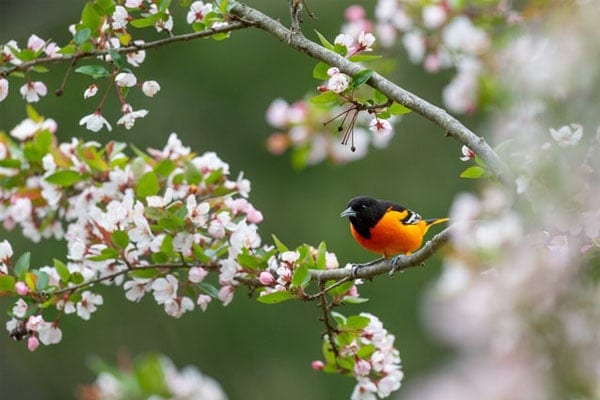
photo credit: Ray Hennessy on Unsplash
Baltimore Orioles are still common and widespread. However, it has been found that their numbers are slowly declining.
One of the significant threats to their numbers is deforestation and loss of habitat. At the same time, pesticides on trees kill insects as their food source and sometimes poison them, too. And since these birds migrate at night, they sometimes crash into tall structures when rainstorms and lights distract them.
Lastly, the birds’ eggs, nestlings, and fledglings are threatened by predators, too. Among their common predators are crows, owls, blue jays, black-billed magpies, squirrels, and cats.
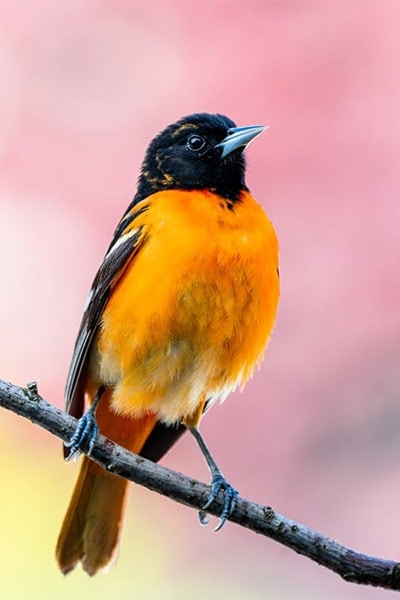
photo credit: Skyler Ewing from Pexels
Fun & Interesting Facts
- The Baltimore Oriole is the state bird of Maryland.
- The bird was named Baltimore Oriole because its color pattern resembles the coat of arms of Lord Baltimore.
- The baseball team Baltimore Orioles was named after this bird.
- Baltimore Orioles’ favorite thing to eat is caterpillars.
- Baltimore Orioles are attracted to the orange color.
- These birds are very sensitive to insecticides.
- The Baltimore Orioles’ sock-like hanging nest is one of the great wonders of the avian world.
Explore More Species in This Family
- Bullock’s Oriole
- Orchard Oriole
- Hooded Oriole
- Scott’s Oriole
- Altamira Oriole
- Audubon’s Oriole
- Spot-Breasted Oriole
- Yellow-headed Blackbird
- Bobolink
- Western Meadowlark
- Eastern Meadowlark
- Red-winged Blackbird
- Tricolored Blackbird
- Shiny Cowbird
- Bronzed Cowbird
- Brown-headed Cowbird
- Rusty Blackbird
- Brewer’s Blackbird
- Common Grackle
- Boat-tailed Grackle
- Great-tailed Grackle
The post Baltimore Oriole: Bird Identification, Habits, Facts, Nesting appeared first on BirdInformer.com.
from BirdInformer.com https://ift.tt/3bgYl4U

No comments:
Post a Comment